
The Pacific temperate rainforests of western North America is the largest temperate rain forest region on the planet as defined by the World Wildlife Fund. The Pacific temperate rainforests lie along the western side of the Pacific Coast Ranges along the Pacific Northwest Coast of North America from the Prince William Sound in Alaska through the British Columbia Coast to Northern California, and are part of the Nearctic realm, as also defined by the World Wildlife Fund. The Pacific temperate rain forests are characterized by a high amount of rainfall, in some areas more than 300 cm (10 ft) per year and moderate temperatures in both the summer and winter months.
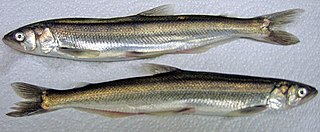
The eulachon, also called the candlefish, is a small anadromous species of smelt that spawns in some of the major river systems along the Pacific coast of North America from northern California to Alaska.

The Peary caribou is a subspecies of caribou found in the High Arctic islands of Nunavut and the Northwest Territories in Canada. They are the smallest of the North American caribou, with the females weighing an average of 60 kg (130 lb) and the males 110 kg (240 lb). In length the females average 1.4 m and the males 1.7 m.

The Western brook lamprey is a small (<18 cm), widely distributed, non-parasitic species of jawless fish endemic to the freshwater coastal waterways of the Western United States and Canada. Its range extends from the North American Pacific coast from Taku River, southern Alaska, Queen Charlotte Islands, to central California, including Vancouver Island, with major inland distributions in the Columbia and Sacramento-San Joaquin watersheds.
The Committee on the Status of Endangered Wildlife in Canada is an independent committee of wildlife experts and scientists whose "raison d'être is to identify species at risk" in Canada. It designates the conservation status of wild species.

The wandering salamander is a species of salamander in the family Plethodontidae. It has a disjunct distribution, with one population being found in northern California in the United States, and another in British Columbia, Canada. It is a matter of debate whether this distribution is the result of human introductions or whether it has natural origins, with the latter conclusion being supported by more evidence. Its natural habitat is temperate forests. It is threatened by habitat loss from logging.

Haliotis kamtschatkana, common name the northern abalone or pinto abalone, is a species of large sea snail, a marine gastropod mollusc in the family Haliotidae, the abalones.
Cryptomastix devia, common name the Puget Oregonian snail, is a species of air-breathing land snail, a terrestrial pulmonate gastropod mollusc in the family Polygyridae.
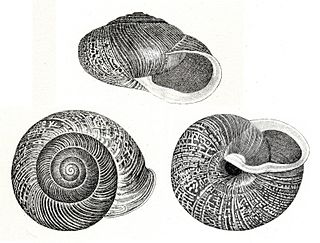
Allogona townsendiana, common name the Oregon forestsnail, is a species of air-breathing land snail, a terrestrial pulmonate gastropod mollusk in the family Polygyridae.
The Hemphillia dromedarius, common name the dromedary jumping-slug, is a species of air-breathing land slugs, terrestrial pulmonate gastropod mollusks in the family Arionidae, the roundback slugs.
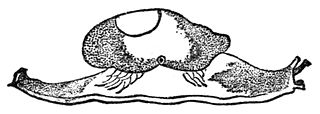
Hemphillia is a genus of air-breathing land slugs, terrestrial pulmonate gastropod mollusks in the family Arionidae, the roundback slugs.

The Hemphillia glandulosa, common name the warty jumping-slug, is a species of air-breathing land slug, a terrestrial pulmonate gastropod mollusk in the family Arionidae.

Gonidea angulata, the western ridged mussel or Rocky Mountain ridged mussel, is a species of freshwater mussel, an aquatic bivalve mollusk in the family Unionidae, the river mussels. It is the only species in the genus Gonidea.
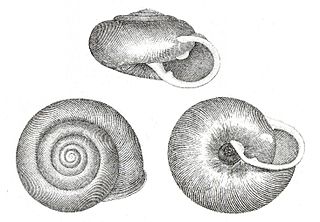
The Appalachina sayana, also known as the Spike-lip Crater, is a species of small, air-breathing, land snails, terrestrial pulmonate gastropod molluscs in the family Polygyridae.

Lupinus rivularis is a species of lupine known by the common name riverbank lupine native to North America. It is also commonly known as river lupine, streambank lupine, and stream lupine.
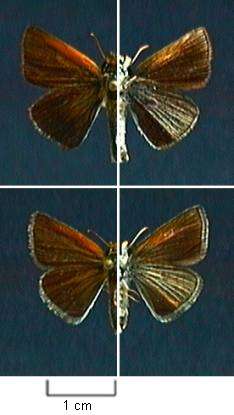
Oarisma poweshiek, the Poweshiek skipperling, is a North American butterfly in the family Hesperiidae (skippers), subfamily Hesperiinae. The range of this species in Canada is restricted to southeastern Manitoba, and in the United States it historically ranged from the Dakotas to the southern Lower Peninsula of Michigan.

Deroceras invadens is a species of air-breathing land slug, a terrestrial pulmonate gastropod mollusc in the family Agriolimacidae. Until 2011, this widely distributed species was known as Deroceras panormitanum, and earlier as Deroceras caruanae or Agriolimax caruanae, but Reise et al. (2011) showed that these names refer to a distinct species of similar external appearance known at that time only from Sicily and Malta. Consequently, although the more widespread species was already well known, it then had to be redescribed under the new name of D. invadens. Genetic evidence has indicated that D. invadens is native in southern Italy, including parts of Sicily, and possibly parts of central Italy. Elsewhere it has been introduced, predominantly within the last 100 years, but its spread has been constrained by cold winter temperatures.

Dolphin and Union Caribou, Dolphin and Union caribou herd, Dolphin-Union, locally known as Island Caribou, are a migratory population of barren-ground caribou, Rangifer tarandus groenlandicus, that occupy Victoria Island in the Canadian Arctic Archipelago and the nearby mainland. They are endemic to Canada. They migrate across the Dolphin and Union Strait from their summer grazing on Victoria Island to their winter grazing area on the Nunavut-Northwest Territories mainland in Canada. It is unusual for North American caribou to seasonally cross sea ice and the only other caribou to do so are the Peary caribou who are smaller in size and population. They were listed as Endangered by Committee on the Status of Endangered Wildlife in Canada (COSEWIC) since November 2017.

Sebastes reedi the yellowmouth rockfish, is a species of marine ray-finned fish belonging to the subfamily Sebastinae, the rockfishes, part of the family Scorpaenidae. It is found in the Eastern Pacific.














